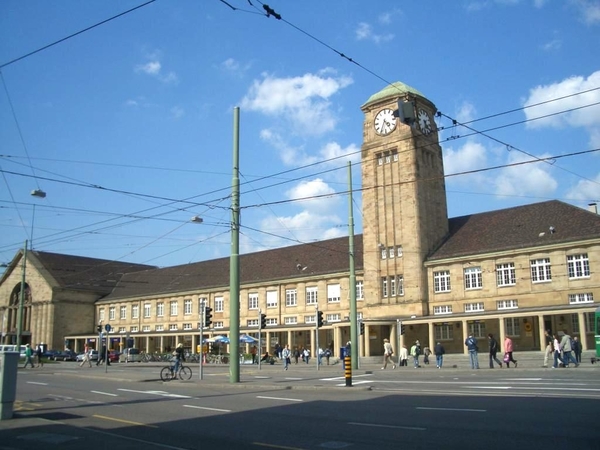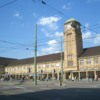Karl Moser, one of the biggest names among Swiss architects in the early 20th century left three masterpieces in Basel: Two churches and a railroad station. Looked at in sequence they show changing tastes in architecture and Moser's own developing style.
Railroad stations aren't as different from churches as you might at first think. While their functional purposes are very different, they nonetheless both have the job of impressing the public with the importance and permanence of the organization. To do this, architects use large spaces, long perspectives, central decorative elements and well-recognized symbols.
Sadly, while his 1905 St Paul Church and the 1929 St Anthony Church are in well-used and well-treated condition, the 1913 Badischer Bahnhof, one of the two main stations, hasn't been given the respect it deserves. The station's exterior still does its job, but many of the interior spaces are now cluttered with random shops, offices and signs.
But even with everything that's been added over the years, there are spaces with dignity, spaces that create connections between interior and exterior, and the exterior itself.
The exterior faces a large plaza with two large statues by Carl Burckhardt, one representing the Rhine, the other the Wiese, a tributary that enters the Rhine near the station. What exactly they are representing about the rivers, I'll leave to others to explain. And congratulations to George G who figured out where these were in our One-Clue Mystery this week.
They're not the only statuary and decoration; at this stage in his journey, Moser (and likely the railroad company) paid a lot of attention to three-dimensional detail, not only the statues but running motifs in columns and elsewhere. The station is listed as a Swiss heritage site of national significance.
And now we come to the station's other story: It exists by a treaty between two countries, is probably the only railroad station in the world with the tracks belonging to one country and the building to another, and it is the only station on Germany's rail system that's not in Germany at all.
In the late 1830s, when railroads were new, and Basel's neighbor, the Grand Duchy of Baden began building one from its capital in Mannheim, down the Rhine valley, more or less toward Basel. In 1842, Switzerland asked Baden to extend the line to Basel, but the two countries couldn't agree on what kind of station to build. So, when it opened in 1851, the line ended at the border and fleets of carriages took passengers the rest of the way.
Note the Customs sign above the door. Once in the corridor, you're effectively in Germany, though still in Basel. The grid in the floor marks the division.
The next year, a treaty between Baden (now part of Germany) and Switzerland set the ground rules: the Baden State Railway would build the station, and Baden would have jurisdiction over the tracks and trains, but the station would be in Swiss territory and run by Swiss. And that's still the pattern, although the original station was replaced by this one. Basel's other main station, across the river, serves Swiss and French trains.
All the paraphernalia of a real border, but no one on hand most of the time.
Because Switzerland is not a member of the European Union, there are still customs issues between the two, and that's reflected in the station, with a part-time customs office. In past years there were also passport controls in the corridor that connects the station to the tracks, but that ended when Switzerland joined the Schengen agreement.
No one seems terribly worried about the unmanned border, guarded most of the time only by this sign that gives the schedule of when an agent is present and announces that outside of office hours it's not permitted to carry goods that are forbidden, but that cash under €10,000 may be. And for anyone who has a problem with that, it invites passengers to somehow get to the 24-hour Customs station on the highway at the edge of the city. Of course, there's no one standing by to see what you do...
And, since Basel is one of Europe's bike-heavy cities, the pedestrian tunnel under the station plaza is lined with bicycle parking, and this sign which I love for the wonderful word that describes what will happen if you park your bike outside the lines.... It will be "abgeschlept." So much better than "hauled off."
Image of station with tower by wladyslaw sojka/Wikimedia



Comments (0)